Federico Benvenuto
PRESOL: a web-based computational setting for feature-based flare forecasting
Oct 02, 2025Abstract:Solar flares are the most explosive phenomena in the solar system and the main trigger of the events' chain that starts from Coronal Mass Ejections and leads to geomagnetic storms with possible impacts on the infrastructures at Earth. Data-driven solar flare forecasting relies on either deep learning approaches, which are operationally promising but with a low explainability degree, or machine learning algorithms, which can provide information on the physical descriptors that mostly impact the prediction. This paper describes a web-based technological platform for the execution of a computational pipeline of feature-based machine learning methods that provide predictions of the flare occurrence, feature ranking information, and assessment of the prediction performances.
Physics-informed features in supervised machine learning
Apr 23, 2025Abstract:Supervised machine learning involves approximating an unknown functional relationship from a limited dataset of features and corresponding labels. The classical approach to feature-based machine learning typically relies on applying linear regression to standardized features, without considering their physical meaning. This may limit model explainability, particularly in scientific applications. This study proposes a physics-informed approach to feature-based machine learning that constructs non-linear feature maps informed by physical laws and dimensional analysis. These maps enhance model interpretability and, when physical laws are unknown, allow for the identification of relevant mechanisms through feature ranking. The method aims to improve both predictive performance in regression tasks and classification skill scores by integrating domain knowledge into the learning process, while also enabling the potential discovery of new physical equations within the context of explainable machine learning.
AI-FLARES: Artificial Intelligence for the Analysis of Solar Flares Data
Jan 02, 2024Abstract:AI-FLARES (Artificial Intelligence for the Analysis of Solar Flares Data) is a research project funded by the Agenzia Spaziale Italiana and by the Istituto Nazionale di Astrofisica within the framework of the ``Attivit\`a di Studio per la Comunit\`a Scientifica Nazionale Sole, Sistema Solare ed Esopianeti'' program. The topic addressed by this project was the development and use of computational methods for the analysis of remote sensing space data associated to solar flare emission. This paper overviews the main results obtained by the project, with specific focus on solar flare forecasting, reconstruction of morphologies of the flaring sources, and interpretation of acceleration mechanisms triggered by solar flares.
A comprehensive theoretical framework for the optimization of neural networks classification performance with respect to weighted metrics
May 22, 2023Abstract:In many contexts, customized and weighted classification scores are designed in order to evaluate the goodness of the predictions carried out by neural networks. However, there exists a discrepancy between the maximization of such scores and the minimization of the loss function in the training phase. In this paper, we provide a complete theoretical setting that formalizes weighted classification metrics and then allows the construction of losses that drive the model to optimize these metrics of interest. After a detailed theoretical analysis, we show that our framework includes as particular instances well-established approaches such as classical cost-sensitive learning, weighted cross entropy loss functions and value-weighted skill scores.
Physics-driven machine learning for the prediction of coronal mass ejections' travel times
May 17, 2023Abstract:Coronal Mass Ejections (CMEs) correspond to dramatic expulsions of plasma and magnetic field from the solar corona into the heliosphere. CMEs are scientifically relevant because they are involved in the physical mechanisms characterizing the active Sun. However, more recently CMEs have attracted attention for their impact on space weather, as they are correlated to geomagnetic storms and may induce the generation of Solar Energetic Particles streams. In this space weather framework, the present paper introduces a physics-driven artificial intelligence (AI) approach to the prediction of CMEs travel time, in which the deterministic drag-based model is exploited to improve the training phase of a cascade of two neural networks fed with both remote sensing and in-situ data. This study shows that the use of physical information in the AI architecture significantly improves both the accuracy and the robustness of the travel time prediction.
Narrowband Transmit Beam Pattern in medical ultrasound: a stochastic approach to delays optimization
Sep 13, 2022
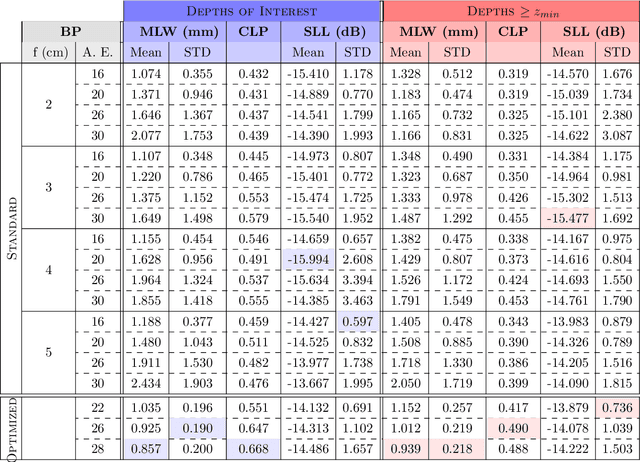
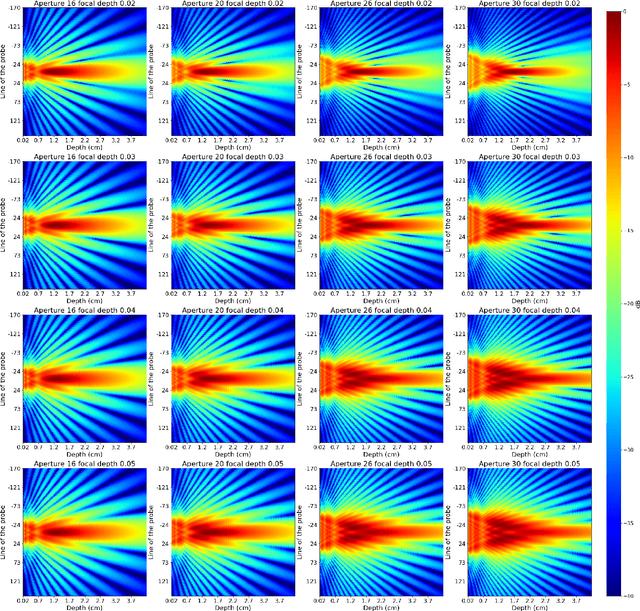

Abstract:Transmit Beam Pattern (TBP) optimization is an important task in medical ultrasound especially in some advanced applications like continuous wave Doppler or shear wave generation in acoustic radiation force impulse elastography. Standard TBP is based on transmission focused at a fixed focal depth: this results in well-known drawbacks like non-uniform beam width over depth, presence of significant side lobes and quick energy drop out after the focal depth. To overcome these limitations, in this work we present a novel optimization approach for TBP by focusing the analysis on the narrow band approximation of the TBP and considering transmit delays as free variables instead of linked to a specific focal depth. We formulate the problem as a non linear Least Squares problem to minimize the difference between the TBP corresponding to a set of delays and the desired one, modeled as a 2D rectangular shape elongated in the direction of the beam axis. The narrow band case leads naturally to reformulate the problem in the frequency domain, with a significant computational saving with respect to time domain. The optimized narrowband beam patterns have been compared with a large set of standard ones, showing an overall improvement of desired features, thus demonstrating the effectiveness of the proposed approach. Moreover, in order to allow a quantitative evaluation of the improvement, a novel set of metrics is introduced.
Operational solar flare forecasting via video-based deep learning
Sep 12, 2022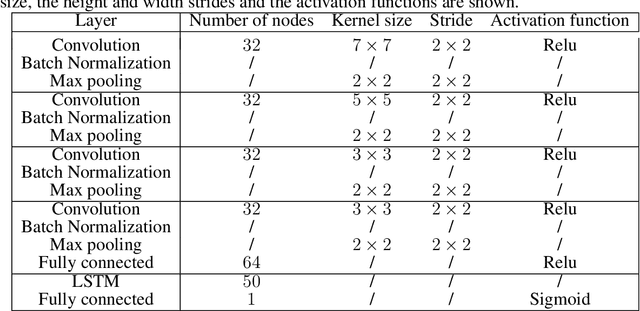

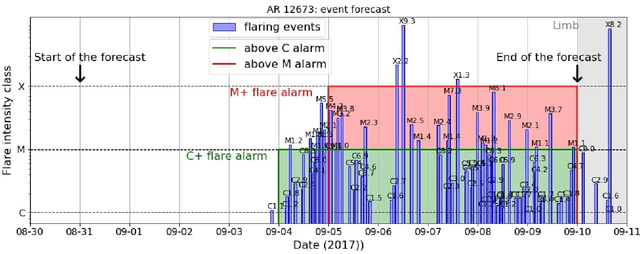

Abstract:Operational flare forecasting aims at providing predictions that can be used to make decisions, typically at a daily scale, about the space weather impacts of flare occurrence. This study shows that video-based deep learning can be used for operational purposes when the training and validation sets used for the network optimization are generated while accounting for the periodicity of the solar cycle. Specifically, the paper describes an algorithm that can be applied to build up sets of active regions that are balanced according to the flare class rates associated to a specific cycle phase. These sets are used to train and validate a Long-term Recurrent Convolutional Network made of a combination of a convolutional neural network and a Long-Short Memory network. The reliability of this approach is assessed in the case of two prediction windows containing the solar storm of March 2015 and September 2017, respectively.
Prediction of severe thunderstorm events with ensemble deep learning and radar data
Sep 20, 2021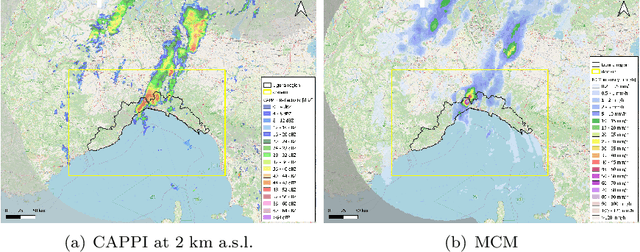



Abstract:The problem of nowcasting extreme weather events can be addressed by applying either numerical methods for the solution of dynamic model equations or data-driven artificial intelligence algorithms. Within this latter framework, the present paper illustrates how a deep learning method, exploiting videos of radar reflectivity frames as input, can be used to realize a warning machine able to sound timely alarms of possible severe thunderstorm events. From a technical viewpoint, the computational core of this approach is the use of a value-weighted skill score for both transforming the probabilistic outcomes of the deep neural network into binary classification and assessing the forecasting performances. The warning machine has been validated against weather radar data recorded in the Liguria region, in Italy,
Bad and good errors: value-weighted skill scores in deep ensemble learning
Mar 04, 2021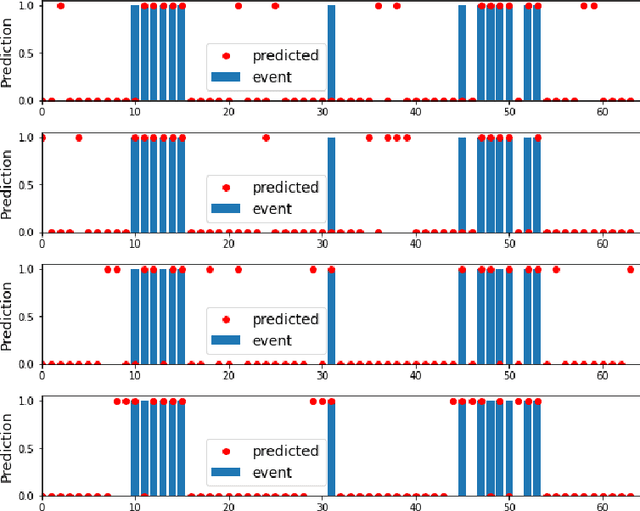
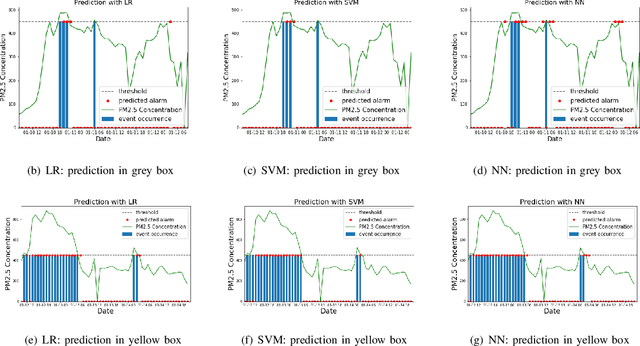
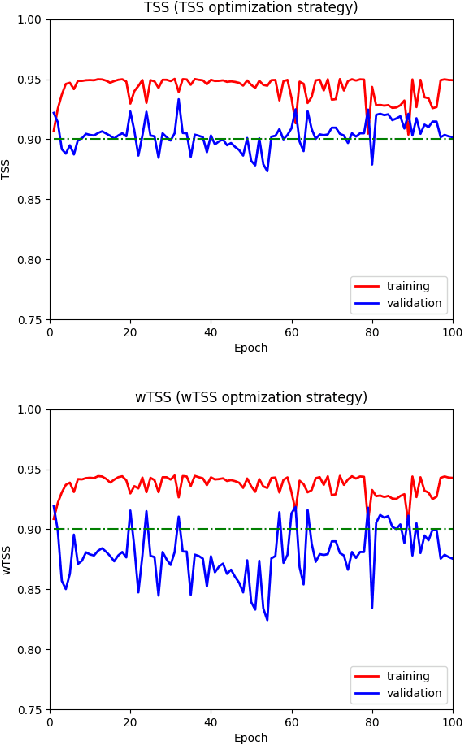
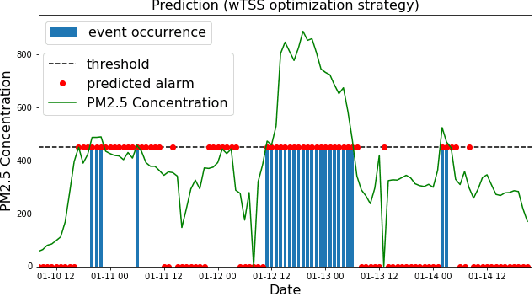
Abstract:In this paper we propose a novel approach to realize forecast verification. Specifically, we introduce a strategy for assessing the severity of forecast errors based on the evidence that, on the one hand, a false alarm just anticipating an occurring event is better than one in the middle of consecutive non-occurring events, and that, on the other hand, a miss of an isolated event has a worse impact than a miss of a single event, which is part of several consecutive occurrences. Relying on this idea, we introduce a novel definition of confusion matrix and skill scores giving greater importance to the value of the prediction rather than to its quality. Then, we introduce a deep ensemble learning procedure for binary classification, in which the probabilistic outcomes of a neural network are clustered via optimization of these value-weighted skill scores. We finally show the performances of this approach in the case of three applications concerned with pollution, space weather and stock prize forecasting.
Machine learning as a flaring storm warning machine: Was a warning machine for the September 2017 solar flaring storm possible?
Jul 05, 2020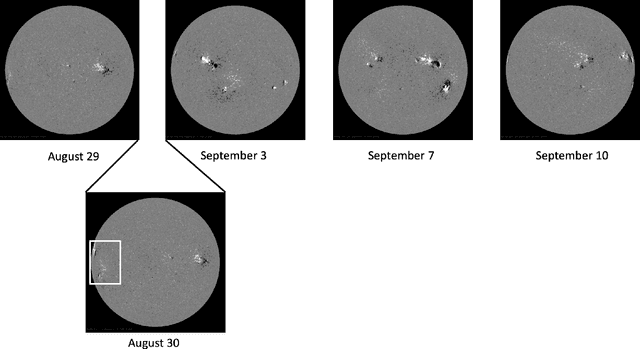
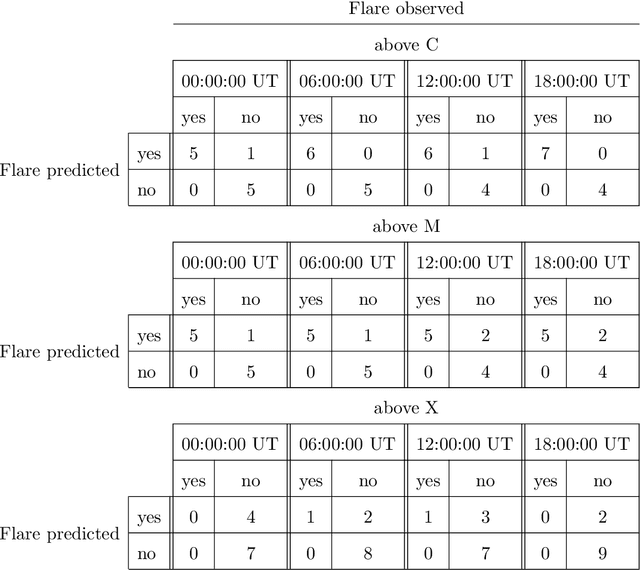
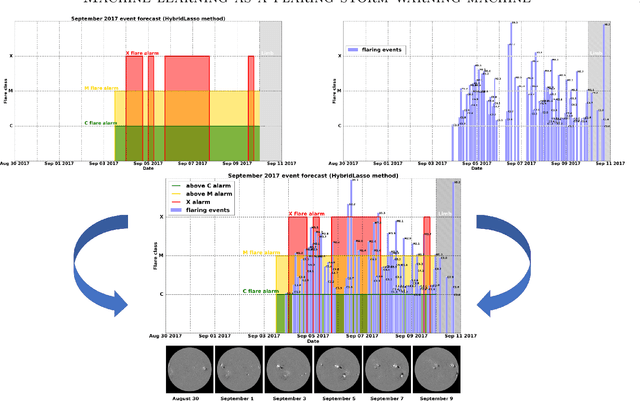
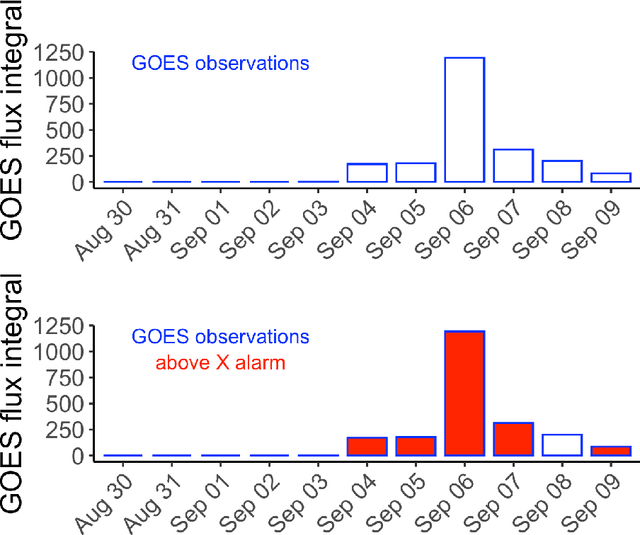
Abstract:Machine learning is nowadays the methodology of choice for flare forecasting and supervised techniques, in both their traditional and deep versions, are becoming the most frequently used ones for prediction in this area of space weather. Yet, machine learning has not been able so far to realize an operating warning system for flaring storms and the scientific literature of the last decade suggests that its performances in the prediction of intense solar flares are not optimal. The main difficulties related to forecasting solar flaring storms are probably two. First, most methods are conceived to provide probabilistic predictions and not to send binary yes/no indications on the consecutive occurrence of flares along an extended time range. Second, flaring storms are typically characterized by the explosion of high energy events, which are seldom recorded in the databases of space missions; as a consequence, supervised methods are trained on very imbalanced historical sets, which makes them particularly ineffective for the forecasting of intense flares. Yet, in this study we show that supervised machine learning could be utilized in a way to send timely warnings about the most violent and most unexpected flaring event of the last decade, and even to predict with some accuracy the energy budget daily released by magnetic reconnection during the whole time course of the storm. Further, we show that the combination of sparsity-enhancing machine learning and feature ranking could allow the identification of the prominent role that energy played as an Active Region property in the forecasting process.
 Add to Chrome
Add to Chrome Add to Firefox
Add to Firefox Add to Edge
Add to Edge